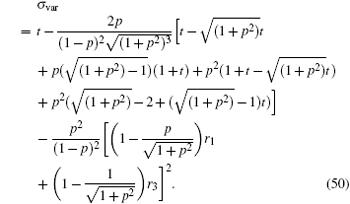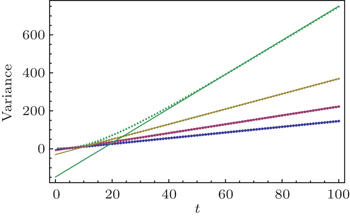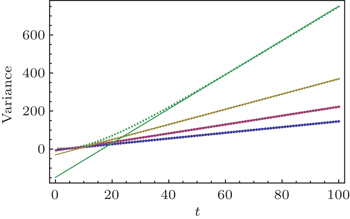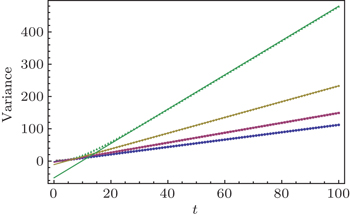† Corresponding author. E-mail:
Project supported by the National Natural Science Foundation of China (Grant Nos. 11174052 and 11474049) and the CAST Innovation Fund, China.
Quantum walks have significantly different properties compared to classical random walks, which have potential applications in quantum computation and quantum simulation. We study Hadamard quantum walks with coins undergoing different quantum noisy channels and deduce the analytical expressions of the first two moments of position in the long-time limit. Numerical simulations have been done, the results are compared with the analytical results, and they match extremely well. We show that the variance of the position distributions of the walks grows linearly with time when enough steps are taken and the linear coefficient is affected by the strength of the quantum noisy channels.
The classical random walk (CRW) is well known due to its diverse applications in many fields, including designing algorithms in mathematics, describing diffusion processes in physics and biology, and stimulating the price fluctuation of stock market in finance. [ 1 – 3 ] Emerging as the quantum analogue of the CRW, the quantum walk (QW) has drawn intense investigation interest in recent years and exhibits striking nonclassical properties, among which the most important one is the ballistic spreading. Hereto, studies have shown that the QW has implications in various fields, such as quantum algorithm engineering, [ 4 – 8 ] quantum simulation, [ 9 – 17 ] universal quantum computing, [ 18 , 19 ] and energy transport in biology. [ 20 ] Experimentally, several different physical systems have been used to implement QWs, for instance, systems of trapped atoms or ions, [ 21 – 29 ] nuclear magnetic resonance, [ 30 , 31 ] and linear optics. [ 32 – 43 ] As real physical systems inevitably suffer from unwanted interactions with the environment, which show up as noise, research taking noise into account on QWs [ 44 , 45 ] is of practical value. QWs with noise have been extensively studied recently, mainly including the noise existing in the graphs on which the walker walks, [ 46 – 49 ] the noise caused by the interaction between the walker or the coin and the environment, [ 50 – 54 ] and the noise imposed on different coins used in the QWs. [ 55 – 58 ]
In this paper, we study discrete-time Hadamard QWs with coins undergoing different quantum noisy channels, including dephasing channel, bit flip channel, and depolarizing channel, which are of significance in quantum systems. By deducing the analytical expressions of the first two moments of position in the long-time limit and direct numerical simulations, we find that the variance of the position distribution of the walks grows linearly with time in the long-time limit, which means the QW is transmitted into the CRW. It indicates that noise which leads to decoherence plays a fundamental role in the transition from the quantum to the classical regime. Besides, the influence of the strength of quantum noise is found to be responsible for the linear coefficient.
This paper is organized as follows. In Section 2, we briefly review the perfect Hadamard QW. In Section 3, we present discrete-time QWs with coins undergoing three different types of quantum noisy channels (dephasing channel, bit flip channel, and depolarizing channel) respectively, and give the analytical expressions of the first two moments of position in the long-time limit. In Section 4, we analyze the results of numerical simulations compared with the analytical results. Finally, in Section 5, we summarize and give a conclusion.
The perfect Hadamard QW is usually considered to be the simplest version of QW, which includes only one walker walking on a line and a two-dimensional quantum coin with no decoherence. Before each step is taken, the Hadamard operator 













Now we discuss the Hadamard QW with decoherence introduced via the coin undergoing quantum noisy channels on the basis of the reviewed content in the above section. The general form of quantum noise applied to the coin state is


















































We simulate the QWs according to the expression


We can clearly see that the variance of the position distribution of the QW grows linearly with time when enough steps are taken. However, we can still see a quadratic growth of the variance in the first several steps, which is significantly different from that in the CRW and is usually considered as a qualitative mark for the quantumness of the QW system. On one hand, the quantumness of the walks stays for longer time with larger p 2 , which means the weakening of the strength of different noisy channels. On the other hand, for the same p 2 , the walk undergoing depolarizing channel takes less steps in the transition from the quantum to the classical regime than that undergoing dephasing channel and bit-flip channel, the results of which are identical for the initial state we choose. Although the steps for the quantum-to-classical transition of the walks are dependent on both the value of p 2 and the type of noisy channel, the number of steps is 100 in our simulations and is obviously big enough for all cases we choose to see the linear growth of variance with time of the walks, which is also confirmed by the fact that the analytical expressions we find in the long time limit match extremely well with the results of numerical simulations. Besides, the linear growth coefficient of variance versus t increases gradually with p 2 , and the linear growth coefficient of variance for the dephasing channel and bit-flip channel is larger than that for the depolarizing channel with the same noisy strength.
We have studied the Hadamard QWs with coins undergoing different quantum noisy channels, including dephasing channel, bit-flip channel, and depolarizing channel. We find the analytical expressions of the first two moments of position in the long-time limit, which match extremely well with the results of the numerical simulations. We show that the variance of the position distribution of the QW grows linearly with time when enough steps are taken, and still exhibits a quadratic growth in the first several steps, which is an important sign of QWs. The linear growth coefficient of variance versus the steps of the walks increases gradually with the weakening of the noise in different noisy channels. It is decoherence transmitting the QW to the classical.
| 1 | |
| 2 | |
| 3 | |
| 4 | |
| 5 | |
| 6 | |
| 7 | |
| 8 | |
| 9 | |
| 10 | |
| 11 | |
| 12 | |
| 13 | |
| 14 | |
| 15 | |
| 16 | |
| 17 | |
| 18 | |
| 19 | |
| 20 | |
| 21 | |
| 22 | |
| 23 | |
| 24 | |
| 25 | |
| 26 | |
| 27 | |
| 28 | |
| 29 | |
| 30 | |
| 31 | |
| 32 | |
| 33 | |
| 34 | |
| 35 | |
| 36 | |
| 37 | |
| 38 | |
| 39 | |
| 40 | |
| 41 | |
| 42 | |
| 43 | |
| 44 | |
| 45 | |
| 46 | |
| 47 | |
| 48 | |
| 49 | |
| 50 | |
| 51 | |
| 52 | |
| 53 | |
| 54 | |
| 55 | |
| 56 | |
| 57 | |
| 58 | |
| 59 |








